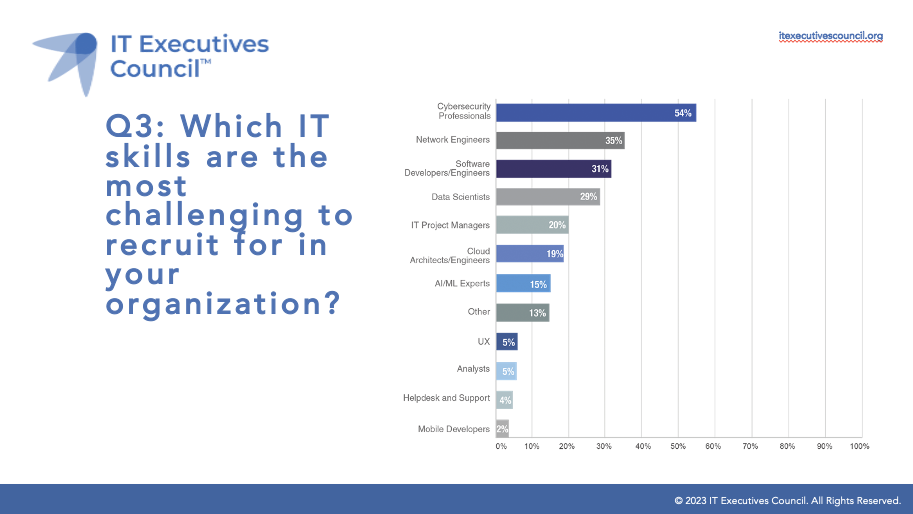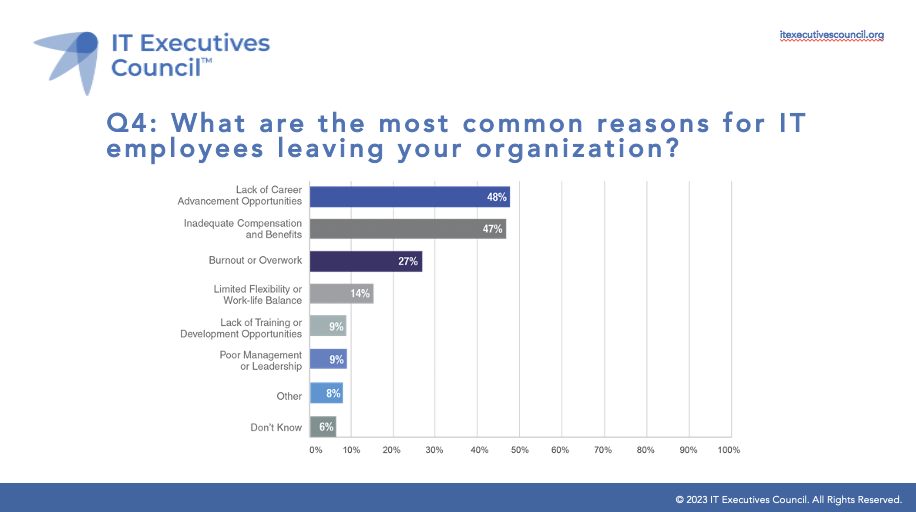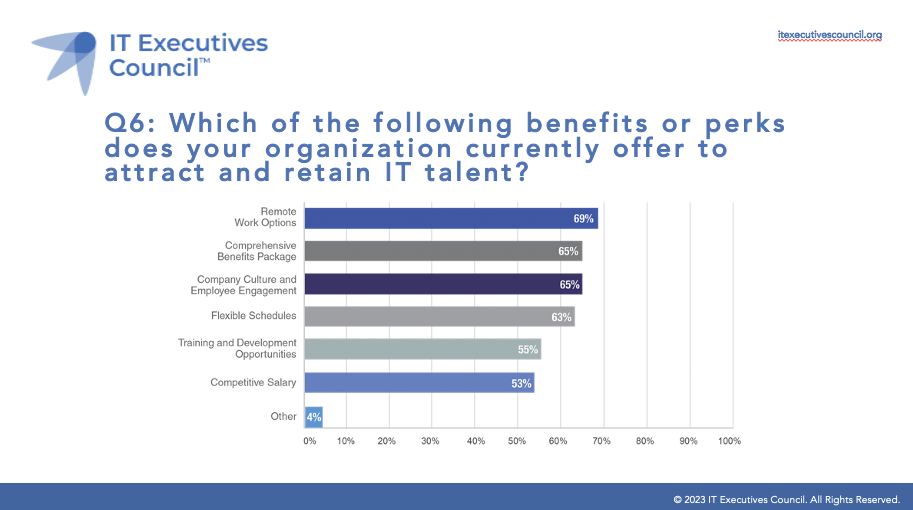IT Executives Council recently held a webinar on the 2023 State of IT Talent.
A national survey was conducted from May to July 2023, with more than 100 respondents participating across North America. Our annual study aims to gather insights on the difficulty in finding IT talent in organizations and the reasons behind it. All right. And by understanding these factors, we’re hoping that CIOs and any of our attendees today can develop effective strategies to attract and retain IT talent which is crucial for staying competitive in today’s technology driven business landscape.
Subject matter experts for this webinar included Mel Heckman and Bob Swanson. Mel Heckman is an accomplished technology executive with nearly 30 years experience in ERP, IT infrastructure, custom development, and business intelligence across a wide range of industries. His many CIO, CTO and technology roles span mid-market to Fortune 500 corporations. And Bob Swanson is president of VAST, a national IT services and infrastructure management firm based in Downers Grove, Illinois.
Following are key takeaways to this discussion. If you are interested in learning more, view the full webinar archive video here.
Nearly 70% of business are struggling to find IT talent

Bob: I would say that it’s been challenging for us as well as we’ve looked to add talent over the last few years, and I know it’s been difficult for many of our customers. Remote work certainly has changed the games and, for companies that have embraced it, it’s opened up the talent pool from one that may have just been local to one that’s regional, national or global. So, this has been a big benefit for some companies and certainly individuals and job candidates, but it’s made it challenging for other companies.
There is a scarcity of cybersecurity and data science professionals

Mel: At the vast majority of, say, mid-market companies and a good chunk of larger companies, and I say mid-market, I’m talking 500 million to a billion and even large companies, it’s almost impossible to create a real tangible career paths for these folks. So many smart people that deserve to get promoted, that deserve to see their career advance and there’s just nowhere to go. And the areas that are hard to create those career paths are the cybersecurity.
And when it comes to the networking, again, the firewalls and all those stuff in the middle, that’s a really niche talent that’s hard to keep people from mid-market people to have. So, it’s those roles that start filling good outsourcing solutions and it helped get rid of that recruiting challenge. But yeah, it’s the career path that’s the kill for most mid-markets.
Lack of career advancement is the leading cause of attrition

Bob: I think some highly talented technical resources can be at their own detriment if they’re too good at a very tactical job that they do. But I guess the other surprise that I would say here would maybe be with the, excuse me, the poor leadership and management clocking in at only 9%. People once said that employees don’t quit their companies, they quit their bosses.
And I think additionally too, we’re mindful here of burnout and overwork and work-life balances. People in our industry are paid well but they’re also asked to work extremely hard for those favorable wages.
Mel: The tricky thing we’re finding in this hybrid model is that the talent pool doesn’t really respect the notion that you live in a smaller community and your cost of living is less. And so, one of the biggest challenges we had was this whole compensation thing where it was taking nothing for people to jump because they were making a 30 or 40 or $50,000 pay raise and that’s huge for most people. So, that became difficult and the only way you can combat that is through giving people additional benefits.
But the thing that you really struggle with IT is this notion that you run out of the sexy stuff to do and the great example of that is analytics. Eventually, a company is going to bring an analytics genius in, and this resource is incredibly smart, all this great stuff and then, eventually, the business is going to fizzle out its need the bang for the buck they get for that. The analytics is going to run out and what keeps that person going or keeps that person motivated is going to call in the question and that’s where you start running the people looking around corners, you know what I mean? And it’s a big problem for small companies too is creating that excitement that lasts more than the first six months to a year.
Flexible schedules and remote or hybrid work are top retention tools

Bob: I think flexible schedules and remote work options are becoming more and more important and desirable by employees and candidates. The nature of IT is always on so many workers are asked to work long hours or hours when the business is closed or others aren’t working or to be on call, those sorts of things.
So, if we’re asking our employees to do those sorts of things, we need to be flexible with them as well and provide the necessary balance to avoid the inevitable burnout that can occur.
Mel: When you think about IT, if you think about your stereotypical IT person, and I’m going to a stereotypical crazy, you got to hark into the inner nerd here and it’s really this notion of a love of learning. And so, what I do and what I’ve done in other organizations is just look for ways to move these IT people into seemingly completely different roles.
To view the complete webcast panel discussion, click here.
To download/read/print the CIO State of IT Talent 2023 Report, click here.




0 Comments